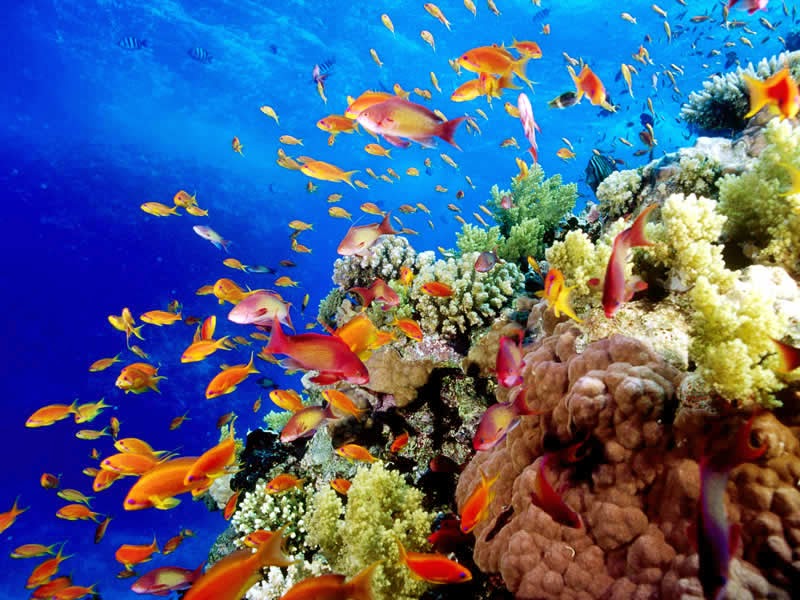I don’t know a single person that does not like the looks of a coral reef. Personally, I love them. In university, I wrote my Bachelor thesis on coral reef ecology, even though I had never seen a coral with my own eyes...but last September that changed when I was on Zanzibar! I made 2 dives there, and finally got to see a lot of real life corals. It was awesome.
There is so much to say about corals that I am going to split it up in several posts. For today we’re gonna stick with the basics. What is a coral? What does it look like? What does it eat? What kind of corals are there? Where do you find them?
 |
| What a coral looks like on the inside |
A coral is an animal (you have no idea how long I lived with the idea that they are plants!) that consists of a polyp (basically a sac-shaped animal) that is housed in a hard external shell to protect the polyp (Pinet, 2009). The polyp has an opening at the top, that functions as his mouth as well as his anus. I know. Gross. I’m glad we got rid of that system somewhere along the evolutionary line.
Around this opening you find tentacles (like in anemones) with special cells that sting (nematocysts), and cells that produce a slimy substance to trap prey. Corals are fixed to the ground, so they cannot actively chase their prey. Instead, they have to wait for tiny bits of plankton to drift into their tentacles. Not the most efficient way of feeding you’d think, but apparently it works, because corals have been around for about 200 million years!
 |
| Plankton! |
 |
| Plankton? |
There are two kinds of corals: corals that have a pact with tiny plant cells, and live in tropical seas (hermatypes) and corals that do not have these tiny plant cells, and can live in deeper, cooler waters (ahermatypes).
Because the zooxanthellae need sunlight for photosynthesis, these corals can only be found in shallow, warm waters. The optimal water temperature for a hermatypic coral is 20°C (Pinet, 2009). Another environmental aspect that controls how well corals grow, is the turbidity of the water. If the water is very muddy, all those little particles block the sunlight, and that means that the plant cells cannot produce enough oxygen for the coral.
 |
| Where to go to find corals |
The corals of the second class do not have plant cells living in their tissue, so for their food they are completely dependent on whatever swims/floats into their tentacles. Lucky for them, they are not restricted to the nutrient poor, warm, shallow waters of the tropics. Cold water corals are not dependent on penetrating sunlight for their zooxanthellae, and they can grow in temperature ranges as low as 4° to 12°C (Murray Roberts et al., 2006). These temperatures are mainly found in the shallow waters of higher latitudes, and in the deep open ocean. In these colder waters, there is much more plankton available for the corals to feed on, so even without zooxanthellae to help them out, cold-water corals are still perfectly capable to feed themselves.
In general, coral reefs are very species rich environments (Snelgrove, 2010) compared to other parts of the ocean. This is because coral reefs can become very complex structures, with many holes and corners for animals to hide in. A very attractive feature for most animals, because living in the open sea isn't exactly what you call safe...So a lot of small and large fish and invertebrates find their shelter on a coral reef, creating an ecosystem that is so diverse it gets called 'rainforest of the ocean'. I like that. In my head I immediately create this image of huge trees under water, and all the fish swimming between the branches.
Unfortunately, just like the real rainforests, the underwater versions are not doing so well...A lot of the reefs around the world are dying, and more than two thirds of coral reefs are in a bad condition. I really hope we can stop it from getting worse, because what would we do without them?!
 |
| Rainforest of the ocean |
References:
Murray Roberts, J.; Wheeler, A.J. and Freiwald, A. (2006) Reefs of the deep: the biology and geology of cold-water coral ecosystems. Science, 312, 543-547.
Pinet, P.R. (2009) Invitation to Oceanography (5th ed.). Sudbury, MA: Jones and Bartlett Publishers.
Snelgrove, P.V.R. (2009) Discoveries of the Census of Marine life. Cambridge: Cambridge University Press.
Pictures:
Top: http://www.wired.com/images_blogs/wiredscience/2012/12/coral_reef.jpg
Polyp: https://www.e-education.psu.edu/earth103/files/earth103/module07/polyp_with_zooxanthellae.jpg
Polyp 2: https://genefish.wikispaces.com/file/view/coral_polyp.jpg/107854669/coral_polyp.jpg
Plankton: http://australianmuseum.net.au/Uploads/Images/7566/e004_big.jpg
Map: http://www.grida.no/images/series/rr-in-dead-water/Figure07.jpg
Coral reef: http://www.annefontainefoundation.org/sites/annefontaine-pny.cmsloungesvn.com/files/Great-Barrier-Reef-Holiday-Reef-Fish12.jpeg

No comments:
Post a Comment